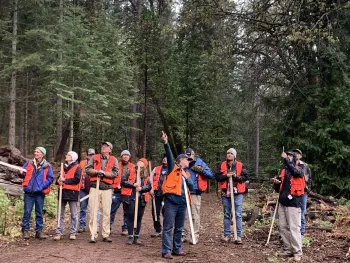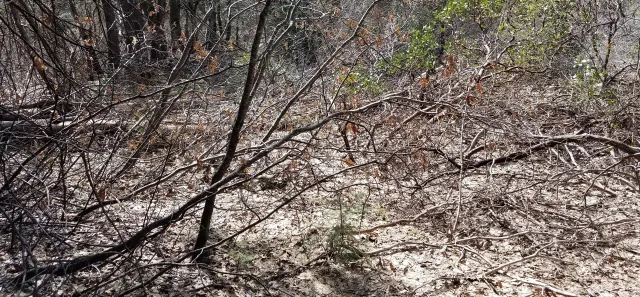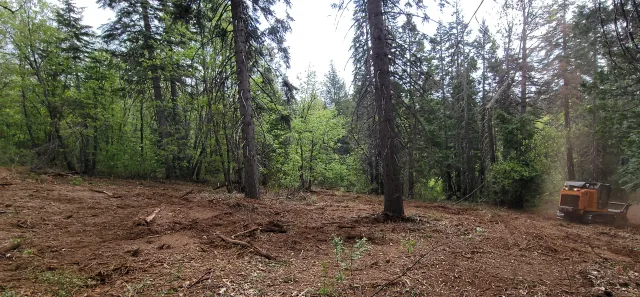
This summer, UC ANR is inviting forest landowners in Yuba, Nevada and surrounding counties to learn strategies for promoting wildfire resiliency and forest health on their land. The UC ANR Forest Stewardship workshop begins July 1st and will guide landowners through different aspects of managing forestland: setting goals, developing and implementing projects, and cultivating working relationships with foresters.
Larry Camp is a Nevada County forest landowner with a wealth of experience in forest stewardship- both in managing his family’s parcels and providing professional assistance to other small, non-industrial landowners. He’s spent decades in the woods as a consulting Registered Professional Forester in private industry and as a forester for Internal Revenue Service. Now semi-retired, Camp spends his time advocating for other landowners as a board member and legislative liaison for the organization Forest Landowners of California (FLC). “I think of my work now as paying it forward. Not every landowner wants or can sit in on every board meeting or legislative hearing, so I advocate for them,” he said. He is also a familiar face in the Forest Stewardship program, serving on its steering committee and educating workshop participants on the finances of forest management.
As California’s wildfires have worsened, he has seen more forest landowners learn how active management can yield multiple benefits. “They want to know what they can do around their property to mitigate fire risk, while also meeting other existing goals,” he shared. Many Forest Stewardship participants cite ecological and aesthetic reasons for owning their land and find that projects for managing wildfire risk can also improve wildlife habitat and forest health.
For example, Camp shared that his parcel had been logged by previous owners, resulting in a widespread growth of competing brush species. Removing the brush via mastication had two effects: converting ladder fuels to surface fuels and reducing resource competition. The project not only improved the forest’s wildfire resiliency; it also gave Camp the ability to replant trees in the masticated area.


Camp also created shaded fuel breaks on his parcels, another management activity that reduces the risk of wildfire. “I’m proud of both those projects, since the fuel break is along the public road, and the mastication created space for new trees as well as reduced wildland fire hazard,” he said.
Like all long-term projects, sound forest management requires a plan. Another proud moment for Camp was when he completed a Non-Industrial Timber Management Plan (NTMP), which he shared was “approved by the state, with minimal changes required.” For Camp, his NTMP is “like a cookbook. It covers everything and provides guidance to my family in the future. It answers the question: ‘Well, what do we do now?’”
The actions of creating a plan and implementing projects require collaboration, and the relationship between a forest landowner and their forester ranks high in importance. Being both a forester and a landowner, Camp knows firsthand the positive impact that a strong partnership can have on a forest. “A forester is like a doctor for your trees,” he said. “Over the course of a few months, they can change the direction of your forest for the next 35-40 years, so it’s important to choose a forester that shares a similar management philosophy.” Beginning the process of interviewing foresters can seem daunting, so a vital resource that the Forest Stewardship Program provides workshop participants is a free site visit with a forester in their area. Landowners equipped with workshop knowledge can then feel confident speaking to foresters and sharing their forest management goals.
Camp also sees the positive impact of dialogue between landowners. “Forest management is as much an art as it is a science, and you may do things wrong. It’s important to learn from others’ successes and mistakes,” he explained. Joining an organization like FLC enables landowners to participate in a statewide learning network, where attending educational seminars and field trips foster interpersonal connections and new learning. Camp shared his recent experience at the FLC annual meeting, where he was inspired by presentations on home hardening, innovations in wildlife monitoring cameras, and new reforestation techniques for redwoods.
There’s a lot of work to be done within California’s forests, with more and more of the public beginning to understand the long-term benefits of managing our state’s forests. In the thick of wildfire season, this growing recognition is something that gives Camp hope for the future. “There are 6.5 million acres of privately owned forestland in California, and that provides a public benefit for wildlife, water supply, and building materials. Managing our forests can substantially reduce the risk of wildfire, and the public cost of suppressing them.”
___________________
Registration is open for the Yuba/Nevada Forest Stewardship Workshop (July 1-August 26)! The series begins July 1, with weekly meetings over Zoom and an in-person field day on Saturday, July 26. Registration is $60, with scholarships available by request. Contact Forest Stewardship Program Academic Coordinator Kim Ingram (kcingram@ucanr.edu) to request a scholarship. Register here.

